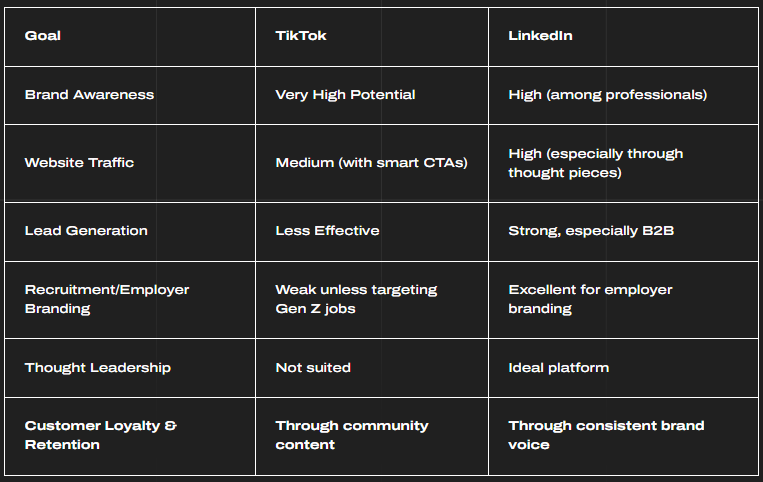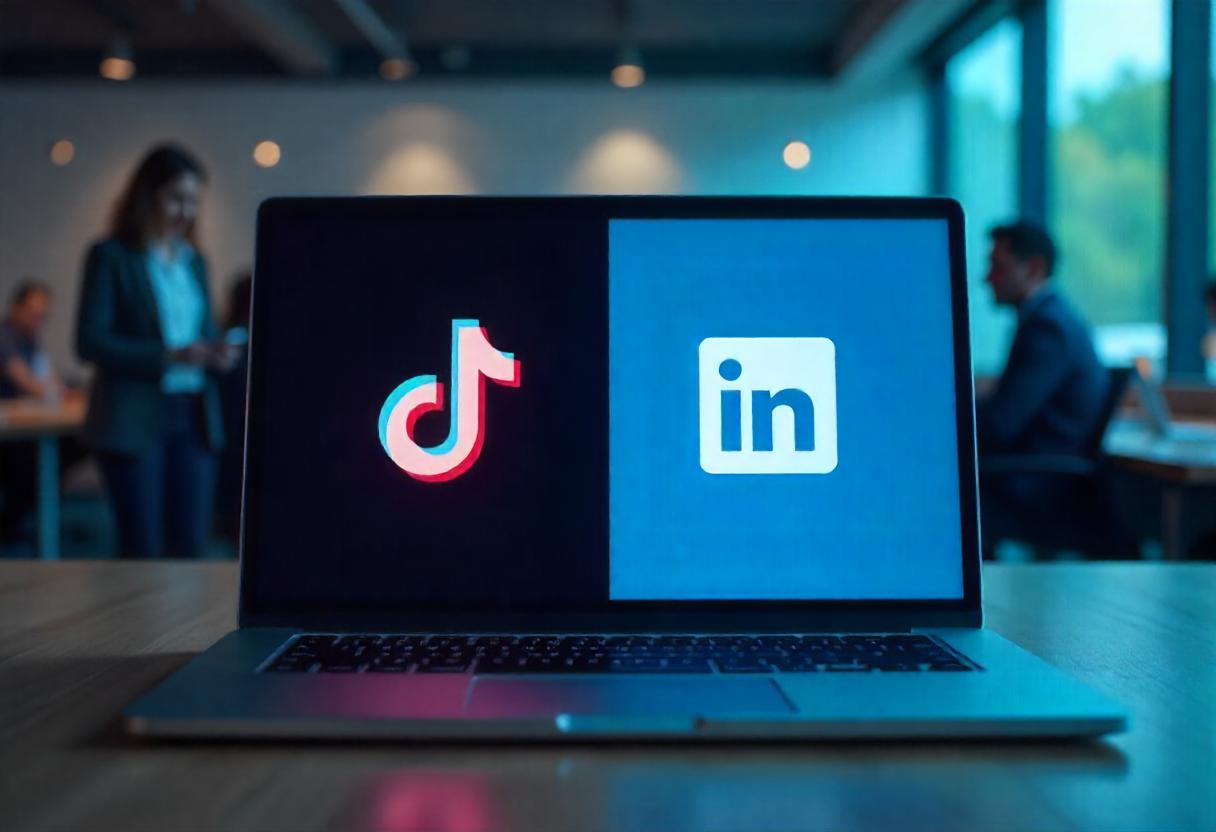Social media is no longer just a place for sharing updates—it’s where brands build communities, host conversations, generate leads, and influence buying decisions. But not all platforms are built for the same purpose. A brand trying to speak the same way across TikTok and LinkedIn will not only confuse its audience but also waste valuable resources.
The challenge is not choosing the most popular platform, but choosing the one that suits your brand’s tone, audience behavior, business goals, and content capabilities.
In this blog, we’ll break down the real differences between TikTok and LinkedIn—from audience demographics and platform culture to content formats and business outcomes—so you can clearly decide where your brand should be.
Understanding the Core Nature of TikTok and LinkedIn
Before comparing their marketing potential, it’s essential to understand what each platform fundamentally represents.
TikTok: Culture, Creativity, and Virality
TikTok is a short-form video platform that thrives on creativity, humor, entertainment, and rapid trend cycles. It is driven by algorithmic content discovery rather than who you follow. This allows unknown creators and brands to gain visibility quickly.
- Audience: Predominantly Gen Z and younger millennials, though older demographics are growing.
- Content Style: Short videos (15 seconds to 3 minutes), informal tone, visually driven.
- Key Engagement: Virality, music trends, challenges, user-generated content, storytelling.
TikTok rewards personality-driven content and thrives on spontaneity. If your brand is comfortable with unpolished formats and thrives in a culturally current space, it can achieve meaningful engagement here.
LinkedIn: Authority, Credibility, and Professional Networking
LinkedIn is a professional networking platform designed for business development, recruitment, industry thought leadership, and professional content sharing.
- Audience: Professionals, decision-makers, B2B marketers, recruiters, entrepreneurs.
- Content Style: Long-form posts, articles, infographics, personal career stories, and company updates.
- Key Engagement: Insights, discussions, company news, employee engagement, thought leadership.
LinkedIn is structured around building credibility and relationships within an industry. If your brand’s objective is thought leadership, B2B lead generation, or talent acquisition, LinkedIn offers a well-suited environment.

Audience Intent and Demographics: Who’s Watching and Why?
The kind of people using TikTok are vastly different in both behavior and intent from those on LinkedIn. Here's a closer breakdown.
TikTok's Audience: Emotionally Connected and Trend-Responsive
TikTok’s core audience falls between ages 16 to 34, with Gen Z dominating the platform. These users are drawn to brands that feel human, honest, and fun. They're also more likely to share and comment on content that evokes emotion—whether that’s laughter, nostalgia, surprise, or even empathy.
Behaviorally, TikTok users:
- Consume content rapidly.
- Are highly trend-conscious.
- Favor brands that speak their language and understand cultural references.
- Expect regular content updates and engagement.
If your audience values entertainment over information and connects more through storytelling than formal messaging, TikTok is a strong candidate.
LinkedIn's Audience: Value-Oriented and Career-Focused
On LinkedIn, users range from 25 to 55, with a concentration in business, tech, finance, marketing, HR, and other knowledge-driven industries. They visit LinkedIn to grow their network, access expert opinions, and stay updated on market trends.
They engage with content that:
- Provides actionable insights.
- Reflects real professional experiences.
- Highlights innovation, leadership, or industry evolution.
- Feels structured and credible.
Unlike TikTok, LinkedIn is not the place for humor without purpose or casual posting. Here, your content must solve problems or add value to the reader’s professional life.
Content Strategy: What Type of Content Performs Best
Content That Works on TikTok: Fast, Raw, Relatable
- Short-Form Video is the default format. But success isn't about high-quality cameras—it's about authentic moments. Brands that show real people, behind-the-scenes snippets, product use in everyday life, or even quick how-tos tend to perform better.
- Trends and Sounds act as content accelerators. Using trending audio clips or memes can put your video in front of thousands quickly.
- Duets and Stitching enable engagement by reacting to or building upon other creators’ content.
- Influencer Collaborations are effective, especially if creators are given creative freedom.
For example, a skincare brand might show a customer’s morning routine with product use in 15 seconds, set to a trending audio clip. The same brand on LinkedIn would need a very different approach.
Content That Works on LinkedIn: Thoughtful, Structured, Trust-Building
- Text-First Posts with engaging intros and clear insights perform best.
- Professional Videos explaining processes, behind-the-scenes team actions, or event highlights can build a stronger brand connection.
- Articles and Whitepapers are appreciated by decision-makers and often shared in professional circles.
- Employee-Generated Content strengthens brand trust and humanizes the company.
- Polls, infographics, and carousel posts are great for drawing engagement in a concise format.
For instance, a B2B SaaS brand might share a client success story or publish data-backed insights on customer retention trends. This would not resonate on TikTok but could generate real leads on LinkedIn.
Goals and KPIs: What Are You Trying to Achieve?
Your business goals determine the platform you should prioritise.

Brand Personality and Content Fit
It’s not just about your audience—it’s about how well your brand’s personality fits within the culture of the platform.
Costs and Content Production Requirements
TikTok
- Production Cost: Low; can shoot content with a phone.
- Frequency: High—users expect multiple videos per week.
- Advertising Cost: Generally cheaper CPM, but not always direct ROI.
- Production Cost: Medium; text and graphic content dominate.
- Frequency: Moderate—1 to 3 times a week is acceptable.
- Advertising Cost: Higher CPM, but often higher-quality leads.
If your brand has limited resources, TikTok might be more accessible content-wise, but it can demand high creative input to remain relevant. LinkedIn, while more expensive in paid campaigns, can yield strong ROI for high-ticket or long-cycle products.

Brand Examples: Who’s Doing It Right?
On TikTok
- Duolingo: A language app using humor, memes, and its owl mascot to stay relevant.
- Gymshark: Fitness brand that works with creators, uses challenges, and posts workout tips.
On LinkedIn
- HubSpot: B2B SaaS brand that publishes insights, industry news, and employee culture posts.
- Salesforce: Shares thought leadership from executives and promotes their CRM solutions with case studies.
These brands stay aligned with the tone and rhythm of each platform rather than cross-posting identical content.
Should You Be on Both Platforms?
A brand can absolutely maintain a presence on both platforms—but only if content strategies are handled independently. Cross-posting the same content on TikTok and LinkedIn without modifying tone, structure, and style can harm your image on both.
If you decide to show up on both:
- Build dedicated content calendars.
- Define separate goals and audience personas.
- Allocate resources appropriately (TikTok for creative video producers, LinkedIn for content writers and strategists).
- Measure success differently on each platform.
Don’t treat social media as a one-size-fits-all tool. It’s a strategic decision that should reflect how your brand wants to be perceived.
Making the Right Call
The answer depends on who you're trying to reach, what message you want to share, and what outcome you’re measuring.
- If your brand thrives on cultural relevance, visuals, humor, and emotional resonance—TikTok is your playground.
- If your brand depends on thought leadership, authority, relationships, and professional engagement—LinkedIn is where you need to build roots.
You don’t need to be everywhere. You just need to be where your audience is—and where you can show up well.



